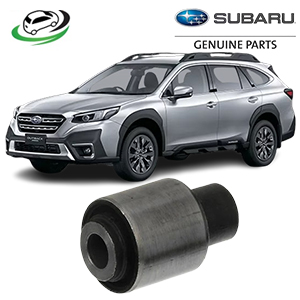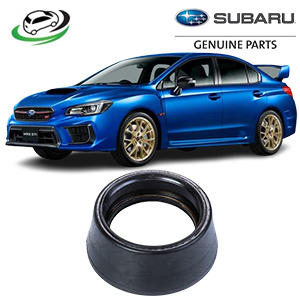-20%
Get Subaru WRX Spark Plug Tube Seal 10966AA042
The spark plug tube seal is a small yet crucial component of your vehicle’s engine, especially in engines where the spark plugs are situated within the valve cover, and a tube runs through to hold them in place. This seal, also known as the spark plug well gasket, helps maintain the integrity of the engine by preventing oil and other contaminants from seeping into the spark plug tube, which could otherwise cause engine misfires and other performance issues.
In this 1000-word guide, we will explore the role of the spark plug tube seal, its benefits, signs of failure, and tips for proper maintenance and replacement.
1. What is a Spark Plug Tube Seal?
A spark plug tube seal is a rubber or rubber-like gasket that sits at the top of the spark plug tube, creating a tight seal between the valve cover and the spark plug tube. This part ensures that oil from the engine’s valve cover area does not seep into the spark plug tube, which could damage the spark plug or lead to engine performance issues.
The spark plug tube seal is particularly common in overhead camshaft (OHC) engines, where the spark plugs are recessed in deep wells that are often integrated into the cylinder head or valve cover. Without a properly functioning tube seal, oil can leak into the spark plug well, causing contamination and potential electrical problems.
2. Functions of the Spark Plug Tube Seal
The spark plug tube seal serves several key functions, making it an important part of your vehicle’s engine system. These functions include:
a. Preventing Oil Leakage
The primary function of the spark plug tube seal is to prevent oil from leaking into the spark plug well. As the engine operates, oil lubricates various moving parts inside the engine, especially under the valve cover. If oil seeps into the spark plug well due to a faulty seal, it can foul the spark plugs and cause poor ignition performance.
b. Keeping Debris and Moisture Out
The seal also helps protect the spark plugs from outside contaminants like dust, dirt, or moisture. These contaminants can compromise the spark plugs’ performance, leading to engine misfires or corrosion.
c. Ensuring Proper Ignition
A well-sealed spark plug tube ensures that the spark plug can fire efficiently without any interference from oil or moisture. Any intrusion into the tube can short-circuit the ignition process, resulting in misfires or poor combustion.
d. Protecting Electrical Components
Oil in the spark plug well can lead to electrical issues since it interferes with the spark plug’s ability to generate a proper spark. The spark plug tube seal prevents oil from coming into contact with electrical components, ensuring the ignition system works as intended.
3. Benefits of a Properly Functioning Spark Plug Tube Seal
A functioning spark plug tube seal provides numerous benefits to the engine’s performance and longevity. Here are some of the main advantages:
a. Improved Engine Performance
With a properly functioning spark plug tube seal, oil and contaminants are kept away from the spark plugs, allowing for consistent ignition and improved engine performance. Without interference from oil, the spark plugs can perform their role optimally, resulting in smoother acceleration and better fuel efficiency.
b. Prevents Engine Misfires
One of the most common causes of engine misfires is oil contamination on the spark plugs. A well-sealed spark plug tube helps avoid this issue by keeping oil out of the spark plug wells. This reduces the likelihood of misfires and ensures the engine operates smoothly.
c. Prolongs Spark Plug Life
By keeping oil and debris away from the spark plug, the seal helps extend the life of the spark plugs. This means fewer replacements and better long-term performance, saving you money on maintenance costs.
d. Protects the Ignition Coil
In some engines, a faulty spark plug tube seal can lead to oil leaking into the spark plug tube and contaminating the ignition coil, which is responsible for generating the high voltage necessary for spark plug firing. This contamination can cause the ignition coil to fail prematurely. A properly functioning tube seal prevents such damage.
e. Reduces Repair Costs
Since a failed spark plug tube seal can cause extensive damage, such as engine misfires, ignition coil failure, or even engine damage, replacing a faulty seal early on can save you from more expensive repairs. Preventive maintenance ensures that you avoid bigger issues down the line.
4. Signs of a Failing Spark Plug Tube Seal
Identifying a failing spark plug tube seal early can prevent significant damage to the engine. Here are some common signs that the seal may be failing:
a. Oil in the Spark Plug Well
One of the most obvious signs of a failing spark plug tube seal is the presence of oil in the spark plug well. If you notice oil on the spark plug itself when removing it, the seal is likely damaged or has become worn.
b. Engine Misfires
If your engine is misfiring, especially under load, this could indicate that oil has seeped into the spark plug well and fouled the spark plug. Misfires occur when the spark plug cannot generate a sufficient spark due to contamination.
c. Rough Idling or Poor Acceleration
A failing spark plug tube seal can lead to rough idling or poor acceleration because the contaminated spark plugs may not be firing correctly. This can result in decreased engine power and poor fuel economy.
d. Check Engine Light
If the spark plug tube seal is leaking and causing engine misfires, it may trigger the check engine light. The light could come on for various reasons, but if combined with other symptoms, it could point to an issue with the spark plug tube seal.
e. Oil Leaks
If oil is leaking from the valve cover and pooling around the spark plug tubes, this could be a sign of a damaged tube seal. In some cases, this may also indicate that the valve cover gasket is failing along with the spark plug tube seals.
5. Maintenance and Replacement of Spark Plug Tube Seals
Proper maintenance of your spark plug tube seals is key to avoiding engine issues and keeping your vehicle running smoothly. Here’s what you need to know about maintaining and replacing these seals:
a. Regular Inspection
It’s a good idea to inspect the spark plug tube seals whenever you perform spark plug replacements or other engine maintenance tasks. Look for any signs of oil leakage around the spark plug wells, as this could indicate that the seal is worn or damaged.
b. Replace Spark Plug Tube Seals During Valve Cover Gasket Replacement
In many vehicles, the spark plug tube seals are located underneath the valve cover. If you’re replacing the valve cover gasket, it’s a good opportunity to also replace the spark plug tube seals, as both components tend to wear out over time.
c. Use High-Quality Replacement Parts
When replacing spark plug tube seals, always use high-quality seals that are designed for your specific vehicle make and model. Low-quality or incorrect seals may not provide a proper fit, leading to premature failure.
d. Professional Replacement
While replacing spark plug tube seals is a relatively straightforward process, it may require removing the valve cover, which can be more complex in some engines. If you’re not comfortable performing this repair yourself, it’s best to have a professional mechanic handle the replacement.
e. Proper Torque on Valve Cover Bolts
If the spark plug tube seals are replaced along with the valve cover gasket, it’s important to properly torque the valve cover bolts during reinstallation. Overtightening or undertightening can cause uneven pressure, leading to leaks or damage to the seals.
6. Steps to Replace a Spark Plug Tube Seal
Replacing the spark plug tube seal usually involves the following steps:
- Disconnect the Negative Battery Terminal
This ensures your safety while working on the ignition system. - Remove the Valve Cover
Depending on your engine’s design, you may need to remove various components, such as ignition coils, to access the valve cover. - Remove the Spark Plug Tube Seal
Once the valve cover is off, locate the spark plug tube seals and carefully pry them out. Some seals may require special tools for removal. - Install the New Seals
Press the new spark plug tube seals into place, ensuring a snug fit. - Reinstall the Valve Cover and Components
After replacing the seals, reattach the valve cover and any components you removed. - Test the Engine
Start the engine and check for any leaks or unusual noises to ensure everything is functioning properly.
Conclusion
The spark plug tube seal is a vital part of the engine, ensuring that oil and contaminants do not interfere with the ignition system. By maintaining and replacing these seals when necessary, you can prevent engine misfires, prolong the life of your spark plugs, and avoid costly repairs. Regular inspection and timely replacement of these seals are essential for the optimal performance of your vehicle’s engine.
Follow us on Facebook for more parts.




Reviews
Clear filtersThere are no reviews yet.